STE Highlights, March 2021
Awards and Recognition
Computer, Computational and Statistical Sciences
Climate science: Modeling unprecedented freshwater spillover into the Atlantic
Materials Physics and Applications
LANL research makes Physics World’s top 10 breakthroughs list
World’s first demonstration of quantum key security for the electric grid
Materials Science and Technology
Leveraging multiscale simulations to predict fission gas release from advanced nuclear fuel
Awards and Recognition
Durham joins leadership of international LHCb experiment
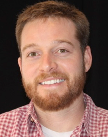
Matt Durham
Matt Durham (Nuclear and Particle Physics and Applications, P-3) has been selected as one of two ion and fixed target conveners for the Large Hadron Collider beauty (LHCb) experiment, which is housed underground at the CERN facility in Switzerland. During his roughly two-year term, Durham—the only conveyor in the collaboration from the United States—will oversee all LHCb analyses in heavy ion collisions.
The LHCb experiment specializes in investigating the slight differences between matter and antimatter by studying a type of particle called the “beauty quark,” or “b quark.” However, an abundance of different types of quarks are created by the LHC before decaying quickly into other forms. Durham’s most recent work focuses on LHCb measurements of an exotic tetraquark candidate.
Massarczyk selected for SURF Executive Committee

Ralph Massarczyk
Ralph Massarczyk (Dynamic Imaging and Radiography, P-1) was selected to serve a one-year term on the Sanford Underground Research Facility (SURF) User Association’s Executive Committee. The committee was founded in December 2020 and consists of nine members that span across the six experiments operating at SURF.
Massarczyk represents the Majorana Demonstrator experiment, which he joined six years ago as a post-doc. At that time, he was helping with early construction of the project. Now, in 2021, Massarczyk recently upgraded the experiment by replacing five of the original detectors with four newly made ones. The detectors are being tested for use in LEGEND-200, a next-generation neutrino-less double-beta decay experiment. This task was complicated by the pandemic.
Massarczyk has watched the South Dakota town where SURF is located evolve from a mining town into a town excited about science. SURF is also garnering international attention from the scientific community, and the new user association will act as a bridge in understanding for both the lay audience and the greater scientific community.
Bioscience
Improving data quality of algal genomics
“Low-quality genomes are more likely to be missing genes and pathways critical to whatever question is being investigated. A genome with incomplete genes gives a misleading view of the algal biology and diversity available,” says Los Alamos computational biologist Erik Hanschen.
Hanschen’s concern is what spurred research into the heart of the issue—an issue that has grown substantially as the barrier to entry into genomic sequencing has declined. Faster, less-expensive sequencing machines have become readily available, and as a result, large swaths of lower-quality data sets are filling publicly available databases.
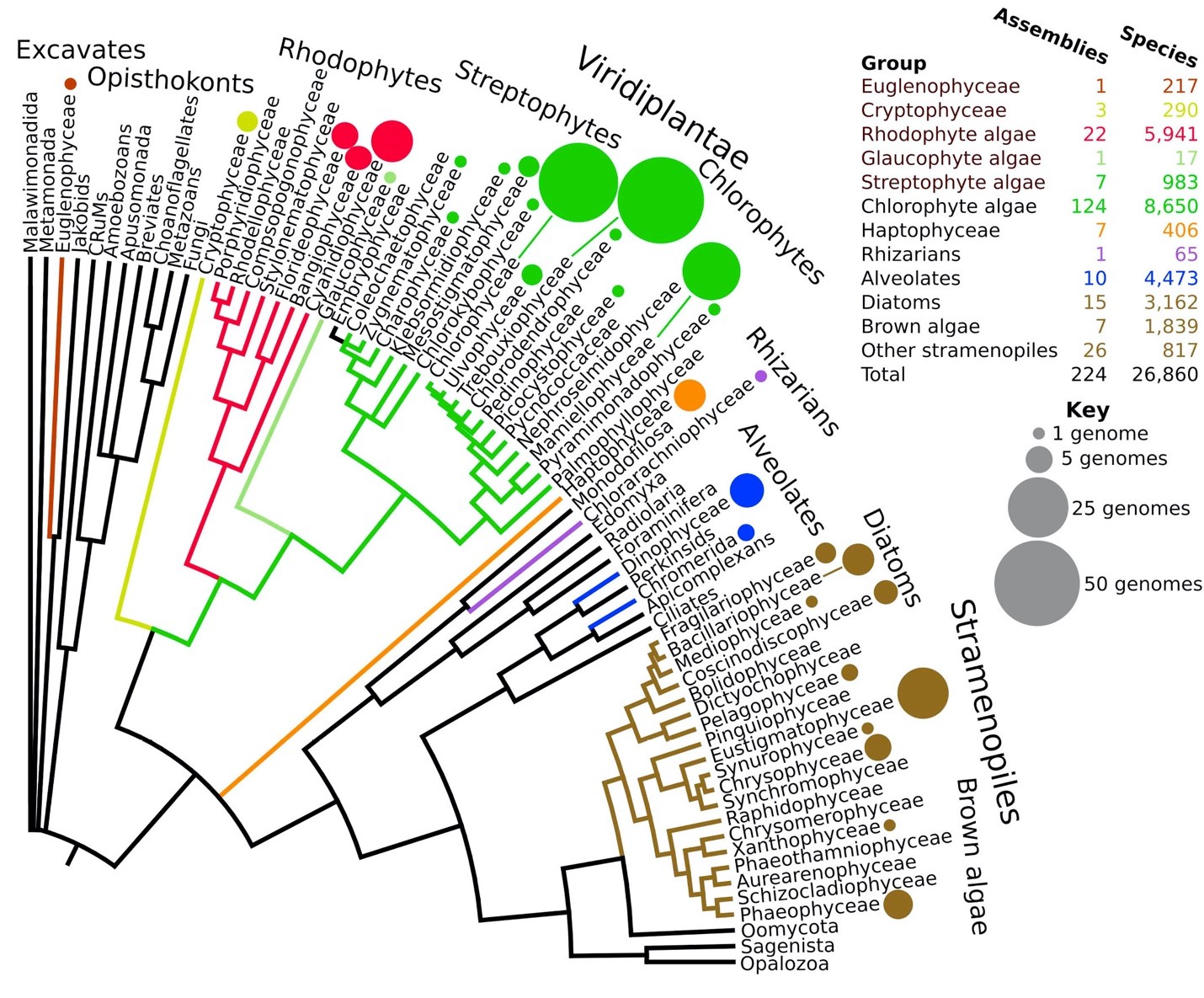
Species distribution of assembled algal genomes showing classes of algae and major groups of non-algae based on recent phylogenomic analyses and reviews.
Sequencing and standards need to improve. In particular, knowledge of algae diversity contributes to the production of biofuels, bioproducts, and medicines.
“We hope to use this data to better understand algal biology and evolution,” Hanschen says. “We also hope to discover novel proteins, biochemical pathways, and untapped natural products by studying these algal genomes.”
However, without sequencing standards and universal benchmarking, these goals may not be easily achieved. Hanschen along with computational biologist Blake Hovde and Applied Genomics Team Leader Shawn Starkenburg evaluated the current state of public databases and the methodology of assessing genomes. The researchers evaluated algal genomes for contiguity, or the completeness of the genome, and gene content. High-quality genomes should include no gaps in sequence.
Additionally, the researchers describe a benchmarking tool—Benchmarking Universal Single-Copy Orthologs (BUSCO)—for evaluating gene content. The BUSCO genes are a well-curated gene set by which public sequences can be compared. Possessing more BUSCO genes is correlated with a higher-quality genome, whereas lower-quality genomes possess fewer of these genes. There are several different databases of BUSCO genes, and selecting the most appropriate database for a given species of algae can also be a challenge.
BUSCO proved to be a helpful quality assurance tool for specific algal lineages, such as Chlorophyta for green algae and Stramenopile for brown algae, but it was not reliable for all algal genomes. Therefore, to improve the quality of public databases, the researchers offered additional strategies. Using specific sequencing technologies that more likely assemble longer contigs and scaffolds whenever possible was one such recommendation. Until additional lineage-specific databases are developed, the researchers promote the use of the Eukaryota database of BUSCO genes, as it is intended for all Eukaryotes. However, it is very clear that lineage-specific datasets are the most valuable and reliable.
Funding and mission
This research was funded by the U.S. Department of Energy, Office of Energy Efficiency and Renewable Energy, Bioenergy Technologies Office. The work supports the Complex Natural and Engineered Systems and Science of Signatures capability pillars.
References:
Erik R. Hanschen, Shawn R. Starkenburg. “The State of Algal Genome Quality and Diversity.” Algal Research 50 (2020) 101968. https://doi.org/10.1016/j.algal.2020.101968
Erik R. Hanschen, Blake T. Hovde, Shawn R. Starkenburg. “An Evaluation of Methodology to Determine Algal Genome Completeness.” Algal Research 51 (2020) 102019. https://doi.org/10.1016/j.algal.2020.102019
Technical contact: Erik Hanschen
Computer, Computational and Statistical Sciences
Climate science: Modeling unprecedented freshwater spillover into the Atlantic
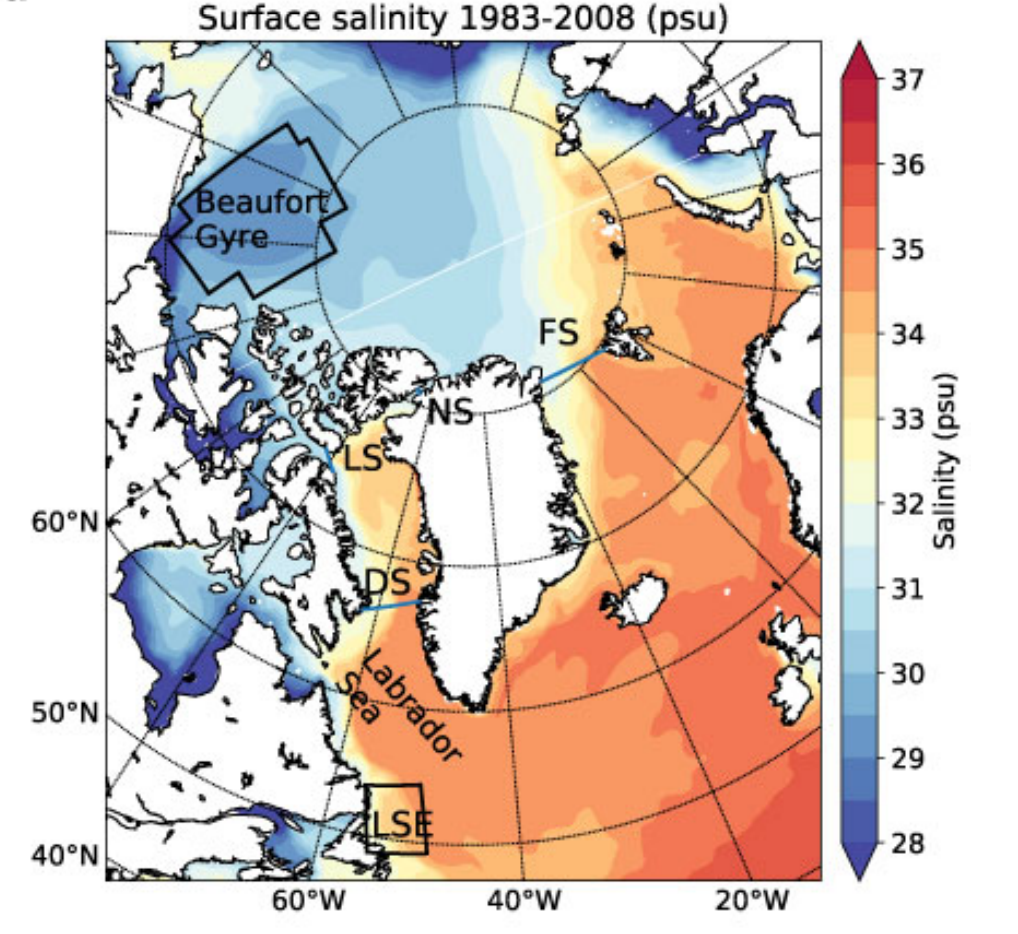
The map shows the study region of the Beaufort Gyre (BG) and major ocean gateways, as well as the BG freshwater content. Climatological surface salinity in the Arctic and the North Atlantic for 1983–2008 is shown on a color scale. Black zigzag box indicates the BG region. Green box, exit of Labrador Sea (LSE); NS, Nares Strait; LS, Lancaster Sound; DS, Davis Strait; FS, Fram Strait.
Freshwater is accumulating in the Arctic Ocean like never before. The Beaufort Sea, which is the largest Arctic Ocean freshwater reservoir, has increased its freshwater content by 40 percent over the last two decades. A rapid release of this freshwater into the Atlantic Ocean could wreak havoc on the delicate climate balance that dictates global weather.
“A freshwater release of this size into the subpolar North Atlantic could impact a critical circulation pattern, called the Atlantic Meridional Overturning Circulation, which has a significant influence on northern-hemisphere climate,” said Wilbert Weijer, Los Alamos Computational Physics and Methods (CCS-2).
A new modeling study by Los Alamos researchers and collaborators from NOAA and the University of Washington dove into the mechanics surrounding this scenario. The team began by studying a previous release event that occurred between 1983 and 1995. Using virtual dye tracers and numerical modeling, the researchers simulated the ocean circulation and followed the spread of the freshwater release.
The study was the most detailed and sophisticated of its kind, lending numerical insights into the decrease of salinity in specific ocean areas as well as the routes of freshwater release. The experiment showed that most of the freshwater reaches the North Atlantic (the Labrador Sea) through a narrow set of passages between Canada and Greenland, called the Canadian Archipelago. This route was previously underestimated and not well known, given that the traditional view considered liquid freshwater transport via the Fram Strait (a passage between Greenland and Svalbard). The freshwater release was shown to significantly reduce the salinities in the Labrador Sea—a freshening of 0.2 psu on the western shelves and 0.4 psu locally in the Labrador Current.
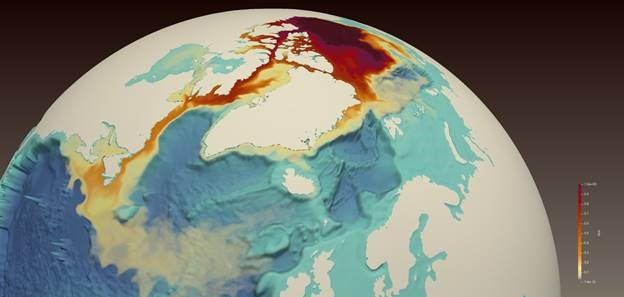
Dye tracer released from the Beaufort Gyre region of the western Artic Ocean indicates freshwater transport through the Canadian Arctic Archipelago into the western Labrador Sea, causing freshening there.
However, the modeled release was based on freshwater volumes of the past, from the 1990s. Now, that volume is significantly greater, more than 23,300 km3, owing to a circulation pattern called the Beaufort Gyre and to unprecedented sea ice decline. If this very large volume of freshwater is released into the North Atlantic, the impacts would be correspondingly very large as well. The exact impact is still unknown.
“Our study of the previous release event offers a picture into the potential impacts of a future, larger release,” Weijer said. Follow up studies will reveal more.
The model used in the study was also partly developed at Los Alamos. It is the Energy Exascale Earth System Model version 0 (E3SMv0), which incorporates LANL’s Parallel Ocean Program (POP) and its powerful sea ice model, CICE.
Funding and mission
This research was funded by the U.S. DOE Office of Science, a LANL LDRD award, a CNLS postdoc fellowship award, and the NOAA. The work supports the Laboratory’s Global Security mission area and the Integrating Information, Science, and Technology for Prediction capability pillar.
Reference: Jiaxu Zhang, Wilbert Weijer, Michael Steele, Wei Cheng, Tarun Verma, and Milena Veneziani. “Labrador Sea freshening linked to Beaufort Gyre freshwater release.” Nature Communications. Accepted January 2021.
Technical contact: Wilbert Weijer
Materials Physics and Applications
LANL research makes Physics World’s top 10 breakthroughs list
In April 2020, research led by Los Alamos Materials Physics and Applications scientists was published in Science Advances—a top journal. The work was groundbreaking, detailing a demonstration of a new x-ray detector that will enable low-dose imaging for dentistry and medicine. The advancement was made possible by 2D layered perovskite diodes.
Less than a week later, Physics World interviewed the Los Alamos corresponding author, Wanyi Nie (Center for Integrated Nanotechnologies, MPA-CINT), to further elucidate the impact of the findings.
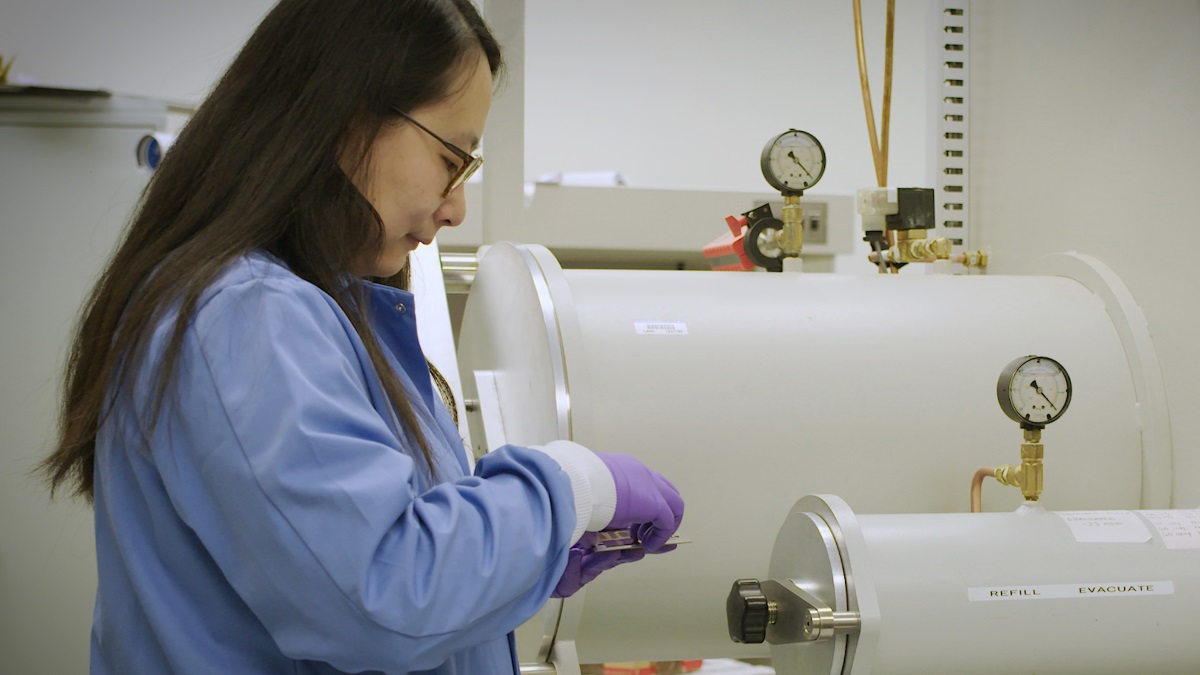
Wanyi Nie holds a prototype x-ray detector produced in her CINT lab.
“Currently, semiconductor detectors are not widely used in large-scale applications because of the cost,” Nie told Physics World. “As we can fabricate our device from solution, one could imagine printing a large, pixelated detector array, which could be drastically cheaper, especially for large-scale imaging applications.”
The full list of improvements and benefits of this technology was astounding.
- The new x-ray detector is 100 times more sensitive than conventional silicon-based devices.
- The detector could dramatically reduce radiation exposure from imaging and associated health risks.
- The detector is self-powered, without an external power source.
- Fabrication of the detector will be cheaper than traditional methods.
- A thinner layer of material (perovskite) offers superior performance to silicon.
- The detector could also boost resolution in security scanners and Advanced Photon Source facilities.
By the end of 2020, Physics World selected this technology for their list of top 10 breakthroughs of the year. The criteria by which the breakthroughs were selected included making a significant advancement in knowledge or understanding as well as demonstrating real-world application.
Funding and mission
The work at Los Alamos was supported by the Laboratory Directed Research and Development program. This work was performed, in part, at the Center for Integrated Nanotechnologies, an Office of Science User Facility operated by the DOE Office of Science. This research also used resources of the Advanced Photon Source, a DOE Office of Science User Facility operated by the DOE Office of Science by Argonne National Laboratory. The research supports the Energy Security mission area and the Complex Natural and Engineered Systems capability pillar.
Eight members of the team were associated with LANL at the time of the work, and one with Argonne National Laboratory: Wanyi Nie, Hsinhan (Dave) Tsai, Fangze Liu, Shreetu Shrestha, Kasun Fernando, Brian Scott (MPA), Duc Ta Vo (NEN), Joseph Strzalka (Argonne), and Sergei Tretiak (T).
References: “A sensitive and robust thin-film x-ray detector using 2D layered perovskite diodes,” Science Advances, 6, 15 (2020). DOI: 10.1126/sciadv.aay0815
Physics World announces its Breakthrough of the Year finalists for 2020
Thin-film perovskite detectors could enable extremely low-dose medical imaging
Technical contact: Wanyi Nie
World’s first demonstration of quantum key security for the electric grid
The national electric grid is fundamental to modern society, yet it suffers from outdated and inefficient technology that is long past its prime. Incorporating quantum techniques into the existing infrastructure could offer unprecedented security, efficiency, and sustainability.
Los Alamos researchers partnered with Oak Ridge National Laboratory, Qubitekk, and a community-based utility and telecommunications company in Chattanooga, Tennessee, to bring this futuristic idea of quantum-ensured security to an actual electric grid. The result was the world’s first successful demonstration of quantum key distribution technology, or QKD.
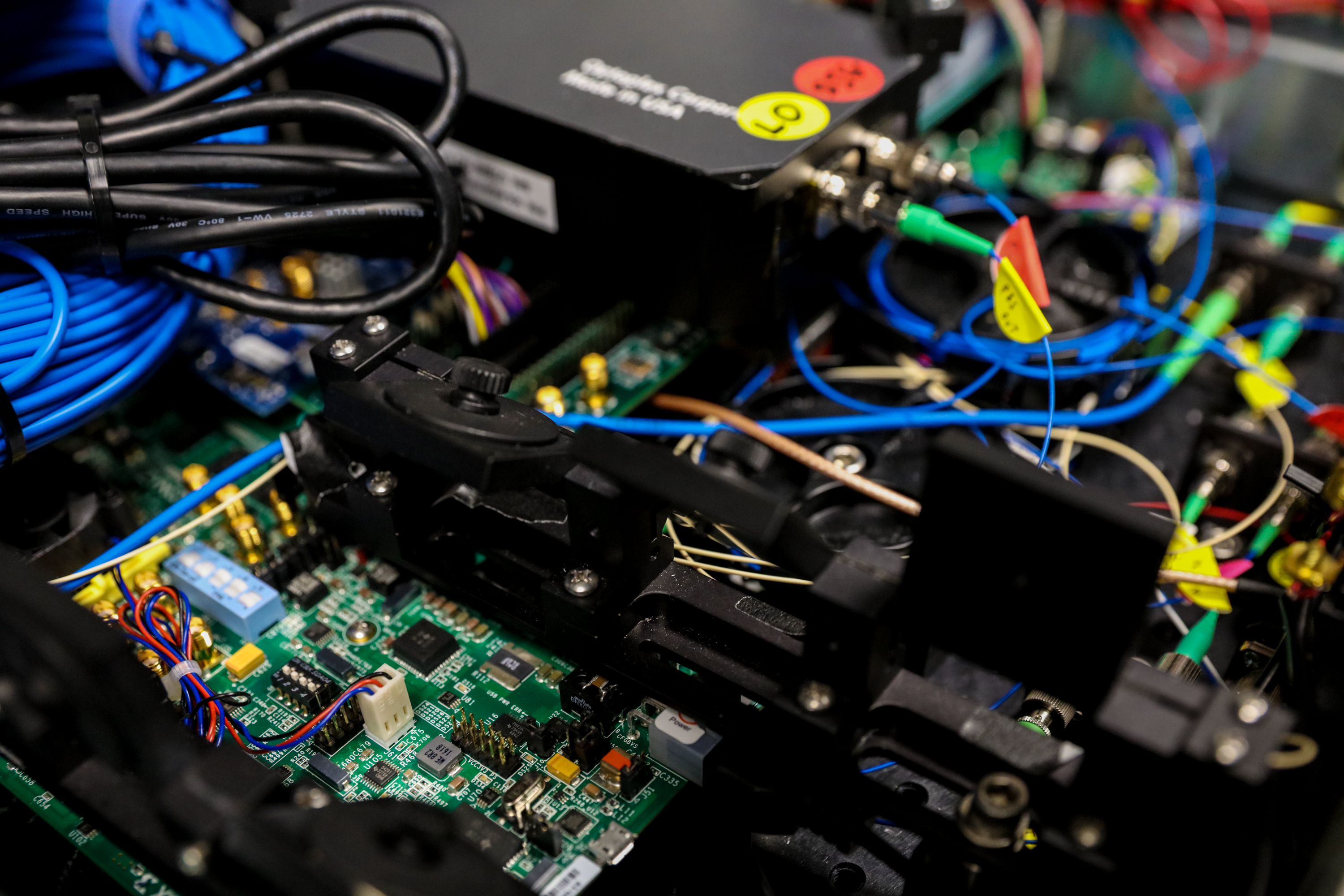
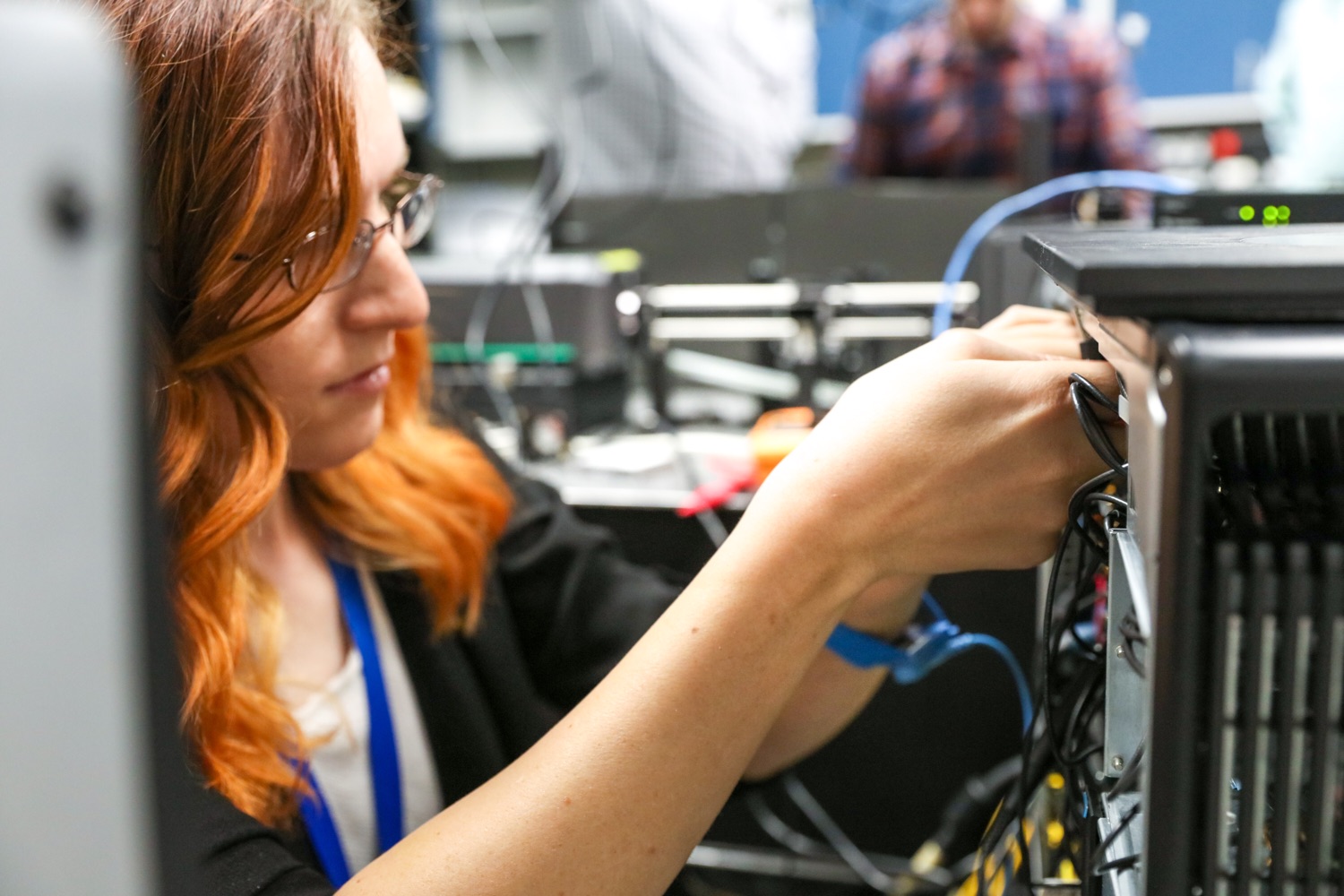
The hardware for quantum-ensured security works seamlessly with existing grid infrastructure and software as well as with varying components from ORNL and EPB, the community-based utility and telecommunications company with whom the LANL researchers partnered.
“QKD functions by securing the links, or nodes, within the electric grid,” said Ray Newell, Los Alamos materials physicist (MPA-Q). “By using encrypted messages with a secret key, information can be transmitted in a way that is virtually invulnerable to cyberattacks.”
It’s true that the demonstration was a major stride in the use of quantum technology, but possibly more important was the seamless integration and expanded range. Three versions of QKD were tested simultaneously, and the hardware and software worked together, demonstrating interoperability of these diverse QKD systems’ keys. The demonstration was the culmination of several years of effort toward proving the feasibility of QKD-based security for energy delivery systems. Despite the inherent obstacles, the researchers were able to cover the entire range of Chattanooga.
The hope is that QKD will be incorporated into the larger national grid. This would be a critical enhancement for national security because QKD can detect the presence of an eavesdropper attempting to intercept or copy information. The interceptions show up as errors, which are then thrown away before they can leak critical information. QKD acts as a simple set-it-and-forget-it technology that can integrate in a plug-and-play manner without elaborate overhead costs or set up. Additionally, QKD benefits the utility providers by allowing the control center to communicate securely issued instructions to all substations simultaneously.
This security is based on quantum mechanical principles, which are timeless and independent from the mathematical laws that govern traditional computer security. That means that QKD could secure the grid for decades, matching or exceeding the service life of the physical infrastructure.
The Chattanooga grid, in particular, is a good representation of what is termed a smart grid—using hierarchical communications with central authority to detect and react to local changes in usage. Smart grids are the key to energy efficiency, and QKD works hand-in-hand with the infrastructure.
Funding and mission
This research was funded by the DOE’s Office of Cybersecurity, Energy Security, and Emergency Response as well as through a collaboration with Oak Ridge National Laboratory. The work supports LANL’s Global Security mission area and the Complex Natural and Engineered Systems capability pillar.
Reference:
Philip G. Evans (Oak Ridge National Lab), Muneer Alshowkan, Duncan Earl (Qubitekk, Inc.), Tyler Morgan (Electric Power Grid), Daniel Mulkey, Raymond Newell, Glen Peterson, Claira Safi, Justin Tripp, and Nicholas A. Peters. “Trusted Node QKD at an Electrical Utility.” IEEE Access. Accepted.
Watch a video: Quantum-ensured security for the national electric grid
Patents: Quantum Key Distribution Using Card, Base Station and Trusted Authority, Patent Number: 2622783 Grant Date: 07/09/2020 Expiration Date: 09/29/2031
Multi-Factor Authentication Using Quantum Communication, Patent Number: 9887976 Grant Date:02/06/2018 Expiration Date: 08/16/2033
Technical contact: Ray Newell
Materials Science and Technology
Leveraging multiscale simulations to predict fission gas release from advanced nuclear fuel
Light-water reactors often use UO2 as nuclear fuel; however, to achieve enhanced fuel performance and reduce the financial costs, researchers are looking to a new class of fuels. These advanced fuels, such as Cr2O3-doped UO2, aren’t well understood and so far can’t be modeled well for useful predictions.
Los Alamos scientists and collaborators tackled this important problem by first establishing a model that employs the cluster dynamics code called Centipede. By incorporating atomistic density functional theory (DFT) data (which was also generated at LANL) into the code, the scientists were able to reproduce experimentally observed irradiation-enhanced xenon (Xe) diffusivity in UO2 for the first time. The code predicted the diffusivities of dozens of Xe-containing defects in UO2, and most importantly, predicted the dominant large Xe clusters that drive irradiation-enhanced diffusion. A critical aspect of the new cluster dynamics model is the use of the oxygen potential of the fuel as an input.
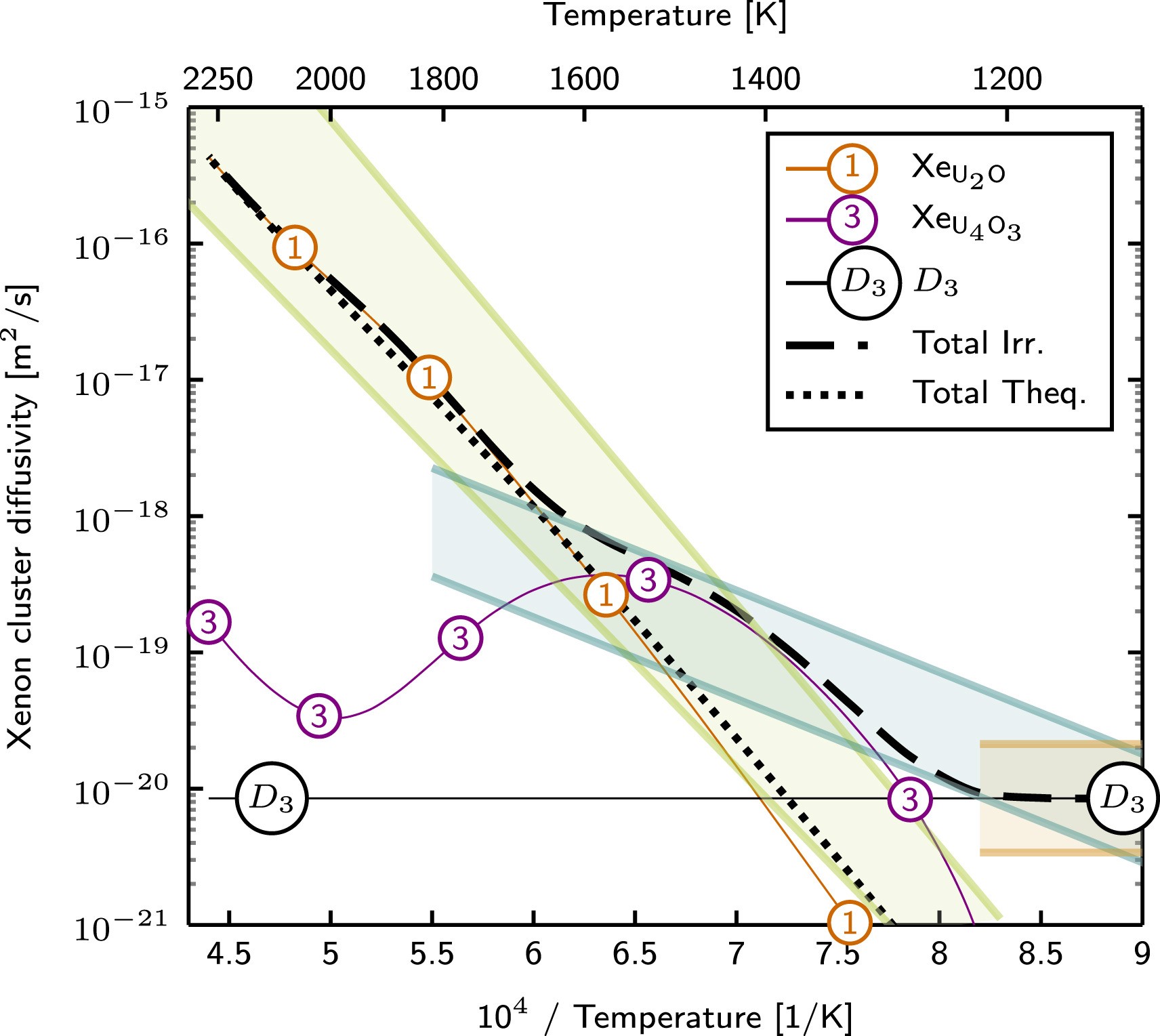
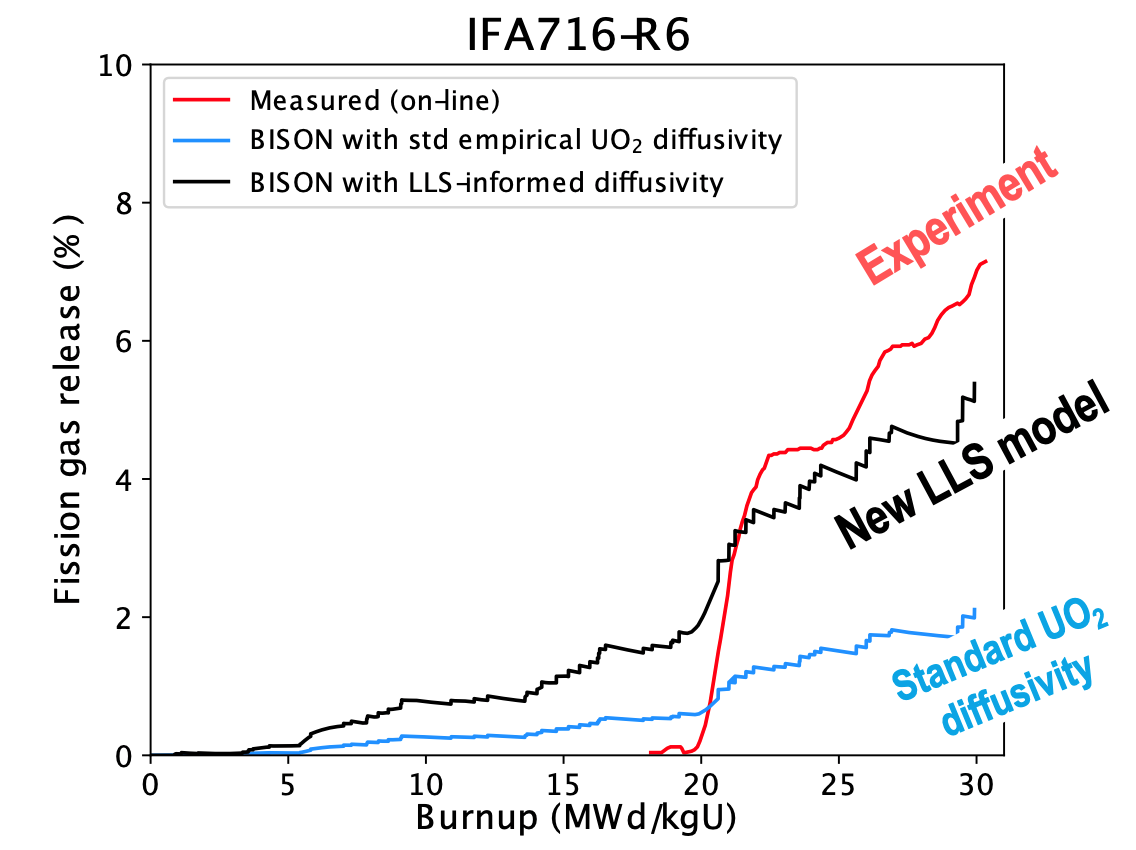
(Top) Cluster dynamics simulations of fission gas diffusivity in traditional UO2 (lines), with comparison to experiment (colored bands). (Bottom) A demonstration of the new model for fission gas diffusivity in doped UO2 for simulations of fission gas release during a Halden Reactor Project test.
This important first step allowed the scientists to create and verify their simulation using experimental data. From there, the scientists applied their model to advanced fuels. Unlike traditional UO2, there is limited experimental data for Xe diffusivity in Cr2O3-doped UO2.
This doping is designed to increase the grain size during fuel fabrication, which is thought to reduce fission gas release. As Xe diffusivity is related to fission gas release, both large grains and enhanced fission gas diffusivity must be accounted for within the mechanistic model of fission gas release to accurately capture the in-reactor performance of doped UO2.
To enable application of Centipede to doped UO2, it was first established, using thermodynamics calculations, that additions of Cr2O3 to UO2 result in a two-phase Cr-Cr2O3 equilibrium that controls the oxygen potential. Implementation of this oxygen potential in Centipede shifts the stability of all point defects and clusters in the system, resulting in an enhancement in Xe diffusivity. As a result, a mechanistic fission gas behavior model was developed—one that offers much-improved agreement with reactor test results.
The work provides motivation for the use of multiscale modeling to assess the performance of other advanced fuels in support of accelerated fuel development.
Funding and mission
This work was sponsored by the U.S. Department of Energy, Office of Science, Scientific Discovery through Advanced Computing (SciDAC) program, as well as by the Office of Nuclear Energy, Nuclear Energy Advanced Modeling and Simulation (NEAMS) program. The research supports the Energy Security mission area and the Integrating Information, Science, and Technology for Prediction capability pillar.
References: C. Matthews (Materials Science in Radiation and Dynamics Extremes, MST-8), R. Perriot (Physics and Chemistry of Materials, T-1), M.W.D. Cooper, C. R. Stanek, and D.A, Andersson (all MST-8), “Cluster dynamics simulation of xenon diffusion during irradiation in UO2,” Journal of Nuclear Materials 540 152326 (2020). https://doi.org/10.1016/j.jnucmat.2020.152326
M.W.D. Cooper (MST-8), G. Pastore (INL), Y. Che (MIT), C. Matthews (MST-8), A. Forslund (KTH Royal Institute of Technology, Sweden), C.R. Stanek (MST-8), K. Shivan (MIT), T. Tverberg (Institute for Energy Technology, Norway), K.A. Gamble (INL), B. Mays (Framatome Inc.), and D.A. Andersson (MST-8), “Fission gas diffusion and release for Cr2O3-doped UO2: from the atomic to the engineering scale,” Journal of Nuclear Materials 545 152590 (2021). https://doi.org/10.1016/j.jnucmat.2020.152590
Technical contact: Christopher Matthews
Physics
Understanding transport and breakup of reactive ejecta
In work appearing in a special issue of Physica D, William Buttler (Applied and Fundamental Physics, P-2) and colleagues investigated two processes thought to influence explosively driven ejecta. These processes include reactive breakup and hydrodynamic breakup of ejecta, which were studied using liquid cerium transporting in hydrogen for the former and liquid tin transporting in deuterium for the latter.
The findings shed light on what has been overlooked in previous research. In essence, ejecta forms when a metal is subjected to a strong shock. A spray of dense particles expels from the back surface of the metal. Although the origins of ejecta are understood, the behavior of ejecta, in terms of recollection onto the shocked surface, and quantification of how much ejecta stays in gas isn’t understood. These things are influenced by breakup processes, and understanding ejecta behavior is critical for industrial and military applications as well as for the physics of fusion.
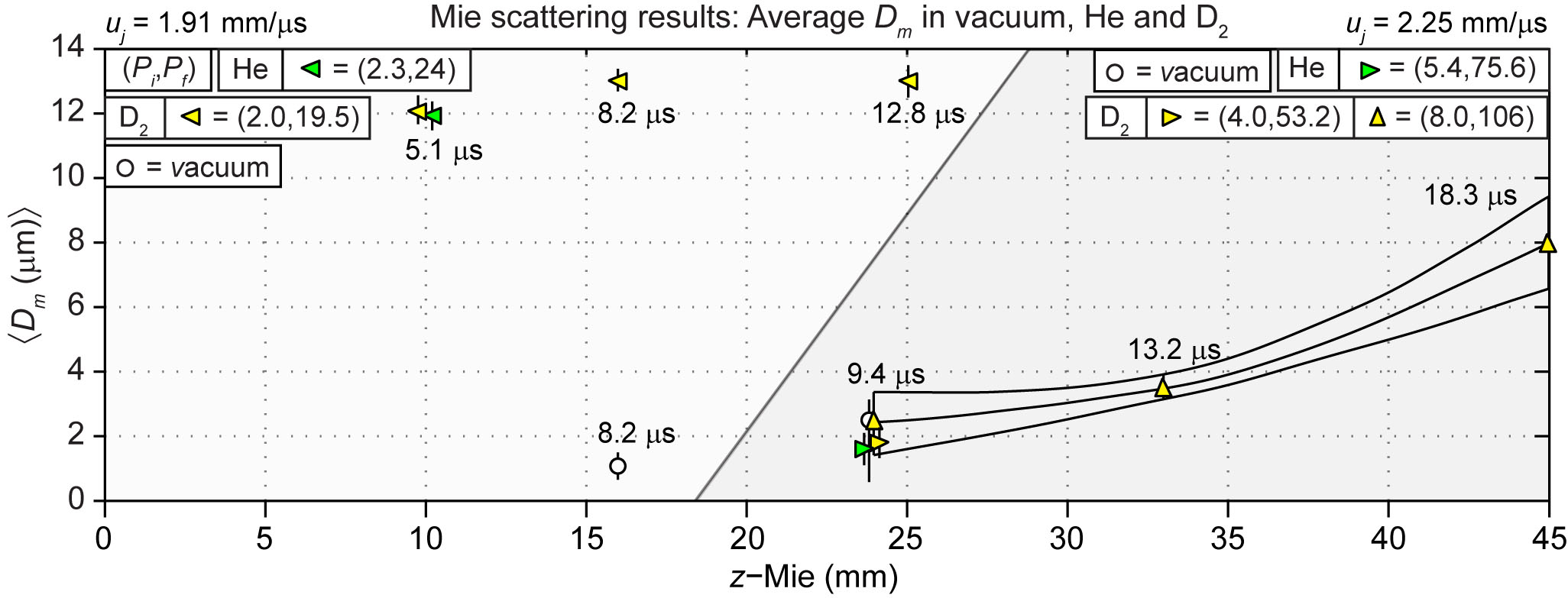
The size data to the left are solid cerium ejecta, and the size data in the shaded region show the exponentially increasing cerium diameters of initially liquid cerium ejecta as caused by reactive processes.
Previously, hydrodynamic breakup was studied, but other processes, such as reactive breakup were not investigated. The current researchers propose that reactive breakup processes lead to more mass coupling to shocked gases than is possible in hydrodynamic breakup of liquid fragments. Their results supported their hypothesis.
Importantly, in contrast to the well-known hydrodynamic breakup of liquid fragments in which large-diameter particles breakup and stabilize at smaller diameters, the diameters of reactive ejecta transporting in reactive gases were seen to exponentially increase with time.
The velocimetry and radiance temperature data on those experiments inferred that smaller particles with diameters < 1- to 2-µm broke up rapidly. The researchers hypothesize that the reactive process proceeds as a CeH2 or CeD2 crust forms on the liquid Ce spray (droplets). The crust limits the reaction of the Ce + H2 to the diffusion of hydrogen through the CeH2. As the Ce reacts to form CeH2, the exothermic reaction heats the CeH2 crust and the liquid Ce core. Once the Ce core and CeH2 reach the melt temperature of the CeH2, the diameter of the particles is then hydrodynamically unstable and the particles rapidly evaporate to leave behind larger-diameter particles that have not yet heated to the melt temperature. This is an avenue the researchers are currently investigating.
The dynamic size data also reveal the inability to describe the partition of ejecta mass that couples to the gas in which the ejecta transport, which is important given that the fundamental interest in ejecta is knowing how much mass is coupled to the gas. However, the researchers’ experimental results combined with Mie theory and the total mass-velocity distribution of the ejecta transporting in the gases suggest an approach to determine this “dark-mass,” or the partition of ejecta mass below lower-resolution limits of our sizing diagnostics. They have also hypothesized new approaches to determine the temperatures of ejecta from these data, without knowing emissivity.
Funding and mission
The work was funded by a Los Alamos Laboratory Directed research and Development Direct Research project, Experimental Sciences Campaigns 1 and 2, and the Advanced Simulation and Computing program for Physics and Engineering Models. The research supports the Lab’s Nuclear Deterrence mission area and Nuclear and Particles Futures and Information Science and Technology capability pillars.
Reference: “Understanding the transport and break up of reactive ejecta,” Physica D 415 132787 (2021). https://doi.org/10.1016/j.physd.2020.132787
Authors: William T. Buttler (P-2), Roland K. Schulze (Surveillance Oversight, W-9), John J. Charonko (P-2), Jason C. Cooley (Fabrication Manufacturing Science, Sigma-1), James E. Hammerberg (W-9), John D. Schwarzkopf (XTD Integrated Design and Assessment, XTD-IDA), Daniel G. Sheppard (Materials and Physical Data, XCP-5), Johnny J. Goett III (P-2), Michael Grover, Brandon M. La Lone (both Special Technologies Laboratory), Steven K. Lamoreaux (Yale University), Ruben Manzanares (Dynamic Imaging and Radiography, P-1), John I. Martinez (Engineered Materials, MST-7), Jonathan D. Regele (Continuum Models and Numerical Models, XCP-4), Martin M. Schauer (P-2), Derek W. Schmidt (MST-7), Gerald D. Stevens, William D. Turley, Ruben J. Valencia (all Special Technologies Laboratory).
Technical contact: William Buttler







